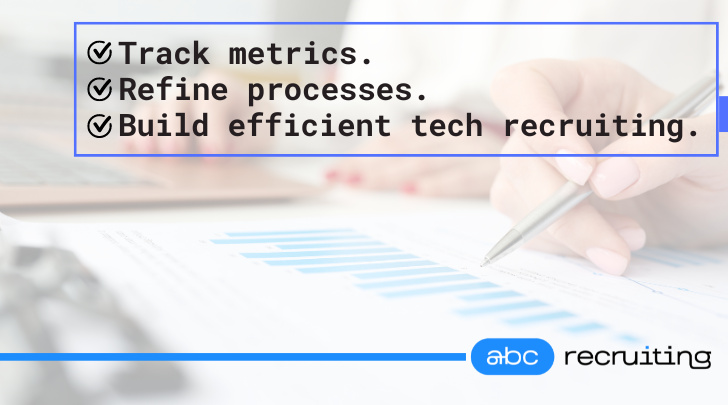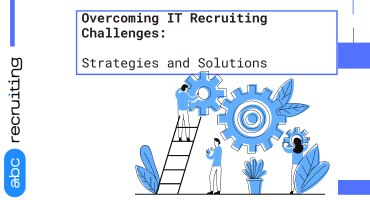How do you know if all the time and money invested in recruitment is actually paying off? As a tech recruiter, maximizing your ROI is key. If you can’t prove the value of your efforts, your budget and headcount may be on the chopping block.
The good news is there are some simple ways to calculate your ROI and make sure your recruitment strategy is firing on all cylinders. You need to start measuring key metrics like time to hire, cost per hire, new hire retention and performance, and the revenue impact of your placements. Then optimize your sourcing, screening, and selection approaches based on the insights you gain.
With the tech skills gap widening, recruitment is more crucial than ever. But resources are tight, and you’ve got to justify every dollar spent. By putting metrics in place to gage your ROI, you’ll gain the insights you need to build an efficient, cost-effective hiring machine. Your company, your candidates, and your career will thank you for it.
Define Key Metrics for Measuring IT Recruitment ROI
To know if your IT recruitment efforts are paying off, you need to start measuring key metrics. Some of the most important ones to track are:
Cost per hire: Calculate how much you're spending to fill each open role. If it's increasing over time, you may need to reevaluate your recruitment channels or negotiate with vendors.
Time to hire: The faster you can fill positions, the lower your cost per hire will be and the sooner new hires can become productive. Aim for filling tech roles within 45-60 days.
Source of hire: Know which channels are generating the most qualified candidates and highest rates of offer acceptance. Don't be afraid to shift more resources to the channels performing the best.
Quality of hire: Once new recruits have been on the job for 6-12 months, evaluate their performance and potential. Look at factors like productivity, work quality, cultural fit, and retention risk. The higher the quality of your hires, the higher your ROI.
Diversity: Aim for recruiting from a diverse range of backgrounds. This helps you find the best talent and also fosters an innovative culture. Track the diversity of your candidate pool and new hires based on factors like gender, ethnicity, age, and education.
Measuring and monitoring these key metrics will help you maximize your success.
You can then tweak your recruitment strategy to improve in areas like lowering costs, reducing time to hire for key roles, optimizing your channel mix, increasing quality and diversity, or boosting the long term ROI of your new hires. The rewards of an optimized recruitment machine are huge. Why not start measuring today?
Track Costs of Your IT Recruitment Efforts
To know if your IT recruitment efforts are paying off, you need to track how much you're spending. Calculate the total cost for each new hire, including:
- Advertising fees for job postings
- Time spent screening resumes and interviewing candidates
- Any travel costs for candidates or your team
- Onboarding expenses like training new hires
- The salary you'll pay the new employee
Compare these costs to the value each new hire will bring to see if you're coming out ahead. For example, if a developer will build a product that generates $200,000 in revenue within 6 months, the $50,000 you spent recruiting them was well worth it.
To maximize your ROI, focus on high-impact roles, streamline your recruiting process, and develop strong hiring skills in your team. Provide regular training on topics like writing effective job posts, interviewing candidates, and assessing technical skills.
Calculate the Revenue Impact of New IT Hires
Now that you have your new IT hire on board, it’s time to calculate the impact they’re having on your revenue and key business metrics. Measuring ROI is key to optimizing your recruiting efforts and budget.
Look at the new hire’s productivity and contributions. Are they completing tasks on time and meeting expectations? Track how much work they're accomplishing each week and the dollar value associated with that work. For example, if their work allows the sales team to generate an additional $10,000 in revenue per week, that’s $40,000 per month or $520,000 per year in ROI.
See how they’re impacting team productivity. Having another set of hands on deck could allow your existing team members to focus on higher-priority or higher-value work. Calculate how much time is saved each week and the revenue value of that time. If the new hire saves 10 hours of work for a senior engineer making $150,000 per year, that’s $6,000 in productivity gains each month.
Check key performance indicators. Examine metrics like customer satisfaction, uptime, page load times, or other KPIs relevant to your business. Look for improvements since the new hire started and determine a monetary value for those gains. Even small boosts can significantly impact revenue and ROI when calculated annually.
Measure cost savings from reduced overtime and contractor hours. The new full-time employee may be able to take over work previously handled by contractors or required overtime from other staff. Add up how much you’re saving in hourly rates and use that total in your ROI calculations.
Calculating the revenue impact of new IT hires and improving your recruiting ROI takes ongoing effort. But by tracking key metrics and continually optimizing your process, you can build an effective and efficient tech recruiting function. Measuring ROI will also help you determine ideal salary ranges, recruiting budgets, and make a case for increased investment in your team.
Analyze Recruitment Campaign Performance and Make Data-Driven Decisions
Once you have analyzed your campaign metrics, make changes to improve your results:
Optimize Your Talent Sources
Double down on the sources that are working by increasing your investment in them. You might place more job ads, target more passive candidates, or build better relationships. Conversely, pull back from underperforming sources.
Refine Your Candidate Experience
Look for ways to streamline the application and interview process. Provide clear job requirements, user-friendly application systems, and a positive candidate experience. This will boost your offer acceptance rates and new hire retention.
Adjust Your Recruitment Strategy
You may need to revisit your overall strategy. For example, if you have a high cost per hire, consider handling more of the recruitment process in-house instead of relying on agencies. Or, if you have poor quality of hire, re-evaluate how you are assessing candidates to make better selections.
Continuously measuring and optimizing your recruitment campaigns will maximize your ROI and help you achieve your hiring goals. Focus on the data and make evidence-based decisions to build a highly productive tech recruitment function.
Optimize Your Recruitment Strategy to Improve Future ROI
To maximize your ROI in the future, you need to optimize your recruitment strategy. Here are a few ways to do that:
Review and revise your job listings frequently. Go through your listings for open roles and make sure the job descriptions are up to date and accurately reflect the position and required qualifications. Also review the benefits and perks you're promoting to ensure they align with what candidates today find most appealing.
Expand your network. Connecting with new people in the industry, joining relevant online communities and networking groups are all ways to improve your reach and connect with more potential candidates. You never know where your next great hire may come from.
Improve your screening process. An optimized screening process can help weed out unqualified candidates sooner and focus your efforts on the best people. Use phone screens, skill assessments, and behavioral interviews to thoroughly evaluate candidates before bringing them onsite.
Refine your interview approach. Make sure your interviewers are well-trained and prepared. Focus interviews on assessing both technical skills as well as soft skills, company culture fit, motivations, and career objectives. Ask behavioral interview questions to determine how candidates may act in real-world scenarios.
Review and revise your onboarding program. Having a structured onboarding program helps new hires become productive as quickly as possible. Review how well your current onboarding is working and look for ways to improve it. Things like mentoring programs, job shadowing, and check-ins can help new employees thrive in those crucial first months.
Continuously improving each step of your recruitment process is key to maximizing your success and ROI. With regular reviews and revisions of job listings, networking, screening, interviewing, and onboarding, you'll hire high-quality candidates, retain them longer, and achieve the best results from your recruiting efforts.
Unlock Your Tech Recruitment's Full Potential!
Ready to enhance your tech recruitment strategy? Connect with us now to drive efficient hiring that yields results.




